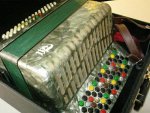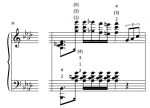donn said:
Stephen said:
How many CBA and PA players look at the bass side stradella buttons before they hit the button?
How many can manage without texture markings?
I think most advanced accordion players can manage without marked buttons.
I understand complete beginners want to have a tactile reference point (eg a C or F marked button) to exercise interval jumps and scales.
Because accordion tuition always starts with playing in the key of C ... (because historically in the 19th century music education was primarily a pianoforte based education, favorising the C scale layout as the basic layout).
But what when you have to start exploring tunes in other keys?
Suppose you have those C and F marked/textured buttons. Okay they can be useful for tactile reference in the keys of C and F.
But in other keys, the function of those C and F notes changes in the scales. From tonic to ...
At this point, those markings/texture can confuse the brain. Suddenly those reference points change function, and they become more an obstacle than an aid to the learner/player...
I'm not a hardliner on marked buttons. My 5 CBAs all have the marked C bass button in the Stradella bass, and I haven't changed this button. These were the factory "settings" and I haven't replaced those buttons. My Hohner Amati 96 bass also has an E marked bass button. But I don't use those tactile markings when I play, I often play a piece in another key, I never have to watch or to feel the markings on buttons.
When I play in other keys (than C) that marked C bass button feels a bit "strange". But I don't pay attention to it, so I can manage to play in all keys.
I agree marked buttons can be help to get a comforting starting grip in the beginning period in the key of C.
But later on it's more an obstacle than a help.
If you have to start practising those longe distance jumps from eg the F Stradella bass button to the E, B or Fsharp bass buttons, you'll have to rely on the frequency of repeats and muscle memory.
Tactile markings won't help much, they just keep reminding you what a wonderful music key C is

(I have nothing against the music key of C. In fact most tunes I play on my CBAs I play them in the key of C. But I also want to feel comfortable playing in duo, trio, ... with other music instruments in another key)



